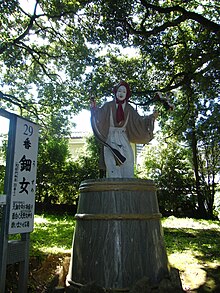Ame-no-Uzume
| Ame-no-Uzume | |
|---|---|
Goddess of the Dawn, meditation, and the arts | |
 The statue of Ame-no-Uzume at Amanoiwato-jinja | |
| Consort | Sarutahiko Ōkami |
| Equivalents | |
| Greek | Eos[1] |
| Hindu | Ushas[1] |
| Roman | Aurora[1] |
| Nuristani | Disani[1] |
| Part of a series on |
| Shinto |
|---|
 |
Ame-no-Uzume-no-Mikoto (Japanese: 天宇受売命, 天鈿女命) is the goddess of dawn, mirth, meditation, revelry and the arts in the Shinto religion of Japan, and the wife of fellow-god Sarutahiko Ōkami. (-no-Mikoto is a common honorific appended to the names of Japanese gods; it may be understood as similar to the English honorific 'the Great'.) She famously helped draw out the missing sun deity, Amaterasu Omikami, when she had hidden herself in a cave. Her name can also be pronounced as Ama-no-Uzume-no-Mikoto. She is also known as Ōmiyanome-no-Ōkami, an inari kami possibly due to her relationship with her husband.[2] She is also known as Ame-no-Uzume-no-Mikoto, The Great Persuader, and The Heavenly Alarming Female.[3] She is depicted in kyōgen farce as Okame, a woman who revels in her sensuality.[citation needed]
Mythology
Amaterasu and the cave
Amaterasu's brother, the storm god Susano'o, had vandalized her rice fields, threw a flayed horse at her loom, and brutally killed one of her maidens due to a quarrel between them. In turn, Amaterasu became furious with him and retreated into the Heavenly Rock Cave, Amano-Iwato. The world, without the illumination of the sun, became dark and the gods could not lure Amaterasu out of her hiding place.

The clever Uzume overturned a tub near the cave entrance and began to dance on it, tearing off her clothing in front of the other deities. They considered this so comical that they laughed heartily at the sight.[4] This dance is said to have founded the Japanese ritual dance, Kagura.[5]
Uzume had hung a bronze mirror and a beautiful jewel of polished jade. Amaterasu heard them, and peered out to see what the commotion was about. When she opened the cave, she saw the jewel and her glorious reflection in a mirror which Uzume had placed on a tree, and slowly came out from her clever hiding spot.
At that moment, the god Ame-no-Tajikarawo-no-mikoto dashed forth and closed the cave behind her, refusing to budge so that she could no longer retreat. Another god tied a magic shimenawa (compare the Nuristani myth of a chaff attaching itself to the thread around a house near heaven) across the entrance.[6] The deities Ame-no-Koyane-no-mikoto and Ame-no-Futodama-no-mikoto then asked Amaterasu to rejoin the divine. She agreed, and light was restored to the earth.
Uzume and Sarutahiko

Amaterasu orders Uzume to accompany her grandson Ninigi on his journey to earth. They head to Ame-no-ukihashi ("floating bridge of heaven") so they could head to earth but they are blocked by Sarutahiko. Uzume comes and persuades Sarutahiko to let Ninigi pass, in other versions of the story Uzume flirts with Sarutahiko. During this journey, she cut the mouth of the sea cucumber with her dagger, causing it to fall permanently silent.[7]
Later, Uzume and Sarutahiko fall in love and get married. Together, they found the Sarume clan.[8][9][10]
Worship

Ame-no-Uzume-no-Mikoto is still worshiped today as a Shinto kami.[11] There are many shrines dedicated to the goddess including Chiyo shrine, Tsubaki America Shrine and Tsubaki Grand Shrine.[12][13] In some, she is worshiped as a patroness of dancers and performers.[7]
Along with her husband, she is addressed during the November festival of Tori-no-ichi in which masks or pictures of the pair are sold.[7]
Similarities to Vedic religion
According to Michael Witzel, Uzume is most closely related to the Vedic goddess Ushas (uṣás), a descendant of the Proto-Indo-European goddess Hausos (*h₂éwsōs), and the Nuristani goddess Disani. Both goddesses share many similarities such as the cave (Vala/Iwato) and the exposure of breasts as a sign of friendship. Witzel proposed that the Japanese, Vedic, and Nuristani religions are much more closely related compared to other mythologies under what he calls Laurasian mythology, and that the three myths, may go back to the Indo-Iranian period, around 2000 BCE. This would make Uzume analogous to the Greek goddess Eos and the Roman goddess Aurora.[1]
References
- ^ a b c d e Witzel, Michael (2005). Vala and Iwato: The Myth of the Hidden Sun in India, Japan, and beyond (PDF).
- ^ "Treasures of the Morikami". Morikami Museum and Japanese Gardens. Archived from the original on 21 July 2016. Retrieved 23 August 2012.
- ^ Herbert, Jean (2011). Shinto: At the Fountainhead of Japan. Taylor & Francis. p. 264. ISBN 978-0-203-84216-4.
- ^ Frédéric, Louis (2002). Japan Encyclopedia. Harvard University Press. pp. 27–28. ISBN 0-674-00770-0.
- ^ Lancashire, Terence (2004). "From Spirit Possession to Ritual Theatre: A Potential Scenario for the Development of Japanese Kagura". Yearbook for Traditional Music. 36. International Council for Traditional Music: 90–108. doi:10.1017/S0740155800020476. ISSN 0740-1558. JSTOR 20058793.
- ^ Addiss, Stephen; Groemer, Gerald; Rimer, Thomas, eds. (2006). Traditional Japanese Arts And Culture: An Illustrated Sourcebook. University of Hawai'i Press. pp. 16–17. ISBN 978-0-8248-2878-3.
- ^ a b c Ashkenazi, Michael (2008). Handbook of Japanese mythology. Handbooks of world mythology. Oxford: Oxford University Press. pp. 111–112. ISBN 978-0-19-533262-9.
- ^ Picken, Stuart D. B. (2004). Sourcebook in Shinto: Selected Documents. Greenwood Publishing Group. ISBN 978-0-313-26432-0.
- ^ Roberts, Jeremy (2009). Japanese Mythology A to Z. Infobase Publishing. ISBN 978-1-4381-2802-3.
- ^ Coulter, Charles Russell; Turner, Patricia (2013-07-04). Encyclopedia of Ancient Deities. Routledge. ISBN 978-1-135-96397-2.
- ^ "Tsubaki Sukeikai" (PDF). Tsubaki Grand Shrine of America. Retrieved 23 August 2012.[permanent dead link]
- ^ "Tsubaki Grand Shrine of America". www.tsubakishrine.org. Retrieved Nov 23, 2020.
- ^ "Chiyo Shrine". Hikone Travel Guide. 5 September 2017. Retrieved Nov 23, 2020.
- Littleton, C. Scott (2002). Mythology: The Illustrated Anthology of World Myth and Storytelling. London: Duncan Baird Publishers. pp. 464–467.


